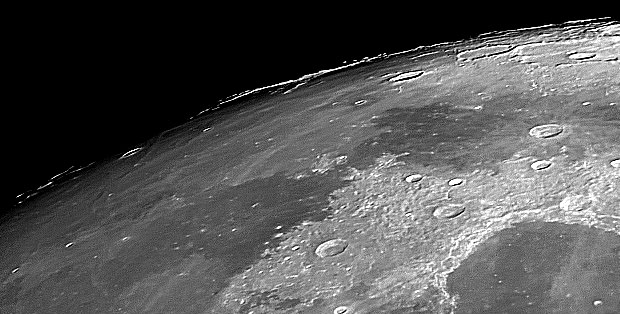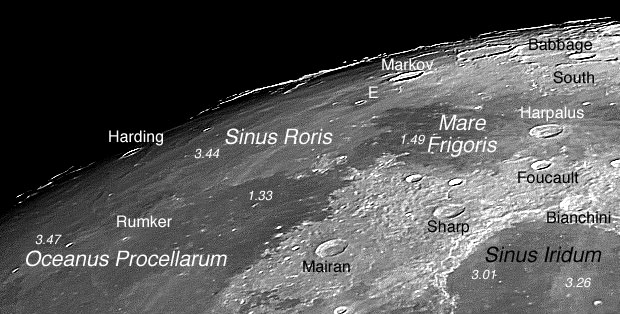November 23, 2015
Telemann Flows
Originally published December 4, 2004
Image Credit: Mario Santiago |
|
Telemann Flows Geologist study units (or formations) that have consistent characteristics and hopefully ages. Two major types of units on the Moon are impact basin deposits (as at Imbrium ejecta at Fra Mauro) and mare lavas. Different mare units are usually distinguished and mapped according to their spectral properties (which are related to compositional differences), and then crater counts done within these spectrally homogenous units determine their ages. This excellent image by Mario Santiago displays the mare units at the northern end of Oceanus Procellarum. Here is a place where chemically different mare lavas with drastically different ages are in close contact and can be distinguished at the telescope because of their brightness differences. Just west of the unnamed peninsula west of Sinus Iridum is a conspicuously dark expanse of mare that is bordered on its west by much lighter lavas. In 1980, Jim Whitford-Stark and Jim Head recognized that the dark lavas were the youngest in this region, and they named them the Sharp Formation. The lighter basalts north of Rumker were named the Telemann Formation. There is one other distinct unit in this area that is exposed around the crater Markov E - this is the Repsold Formation, which is older than the other two units and on;y exposed because the formation of Markov E excavated the buried basalts and ejected them on top of the younger lavas. Over the last few years Harry Hiesinger, Jim Head and their colleagues have been systematically mapping all of the Moon's mare units and estimating ages for them. Based on their crater counts the Sharp lavas are 1.3 to 1.4 billion years old, among the youngest on the Moon. The brighter Telemann flows are dated as 3.4 b.y. and the Repsold basalts are 3.59 b.y. old. So the next time you observe this corner of the Moon try to image the prolonged sequence of eruptions of chemically different lavas starting at ~3.6 b.y., followed by a gap of 200 million years, and then more eruptions at 3.4 billion years . This was followed by an amazingly long gap of 2 billion years, before the Sharp lavas flowed across the surface 1.4 billion years ago. If there was a 2 billion year gap between the last two eruptions maybe we can hope to see yet another one! Technical Details: Related Links: Yesterday's LPOD: A Cozy View of the Moon Tomorrow's LPOD: Ghostly Terrain |
|
Author & Editor: |
COMMENTS?
Register, Log in, and join in the comments.





